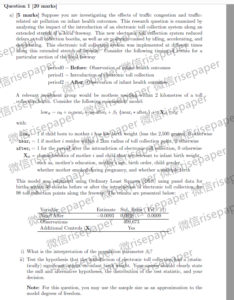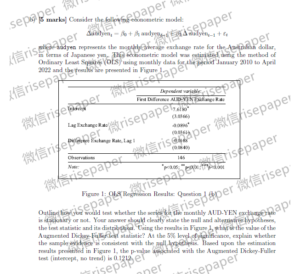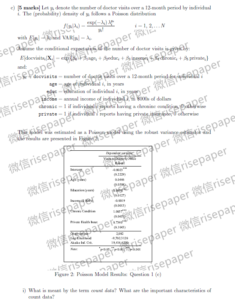


扫一扫又不会怀孕,扫一扫,作业无烦恼。
留学顾问の QQ:2128789860
留学顾问の微信:risepaper
题量偏大,考卷20页左右,建议按照辅导资料准备三整天,即可攻破这门课!
This examination paper contributes 70 percent to the assessment in ECOM30001.
Open Book Status: Yes
You are permitted to use notes, textbooks, or resource materials, as authorised by the Board
of Examiners.
Question 1 [20 marks]
a) [5 marks] Suppose you are investigating the eects of trac congestion and trac-
related air pollution on infant health outcomes. This research question is examined by
analysing the impact of the introduction of an electronic toll collection system along an
extended stretch of a local freeway. This new electronic toll collection system reduced
delays at toll collection booths, as well as air pollution caused by idling, accelerating, and
decelerating. This electronic toll collection system was implemented at dierent times
along this extended stretch of freeway. Consider the following timing of events for a
particular section of the local freeway
period0 = Before: Observation of infant health outcomes
period1 = Introduction of electronic toll collection
period2 = After: Observation of infant health outcomes
Question 4 [20 marks]
Through Medicare, Australia provides individuals with universal access to health care. How-
ever, there can be signicant out-of-pocket expenses associated with treatment in hospitals,
that can be considerably dicult for low-income individuals to absorb. Consequently, the
availability of aordable health care for low-income adults is an important policy question.
The availability of (public) health insurance is one mechanism that can impact the health care
costs faced by low-income individuals. By lowering the cost of health care, health insurance
is expected to increase the utilisation of health care services. What is the impact of health
insurance on the utilisation of health services? Consider the following econometric model:
Types of Data
Data might be collected in the following forms:
time series: follow a country, region, rm or individual over
time
cross-sectional: collects information on several countries,
regions, rms or individuals at a single point in time
panel: follows several cross-sectional units over time
Data may be collected at several levels of aggregation
micro: individuals, households, rms
macro: regional, state, or national
Discrete and Continuous Random Variables
A discrete r.v. can take only a nite number of values that
may be counted using the positive integers 0; 1; 2; : : :
examples of discrete random variables include
1 qualitative outcomes that are an \either-or” situation, such as:
– whether a person is student, or not
– whether a person buys a particular item, or not
– whether a person defaults on their loan, or not
– whether a person resides in a particular region, or not
2 ‘counts’ of particular characteristics or events:
– the number of children in a household
– the number of times an individual visits a doctor over a 3
month period
Statistical Inference代写
process by which we `infer’ or learn something about the real
world by analysing a sample of data
statistical inference might include
1 estimating economic parameters, such as elasticities, using
econometric methods
2 predicting outcomes, such as future levels of GDP, future level
of interest rates
3 testing economic hypotheses, such as:
– Is there an inverse relationship between bond prices and yields?
– Is there a wage premium for workers living in cities?
